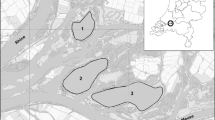Abstract
Cadmium and lead contents in sediments, dominant species of plants (Phargmites aus-tralis andScripus mariquter), benthos (Helice tridens tientsinensis,Ilyoplax deschampsi, andBul-lacta exarata), and waders (Calidris ruficollis) on the Eastern End of Chongming Island were measured. The results showed that, for cadmium, there are clear stratification in the sediment of reclaimed area and bio-amplification in food chain. However, for lead, a phenomenon was different. The amplification factors (AFs) for cadmium of primary producers, primary consumers, and secondary consumers were 2.59–12.38, 0.09–8.44, and 51.1, respectively. For lead, AFs of primary producers, primary consumers and the top trophic layer were 0.29–2.62, 0.06–5.62, and 7.31, respectively. Each species of macrobenthos showed different strategies to cadmium and lead. Large-sized crabs accumulated more lead, while small-sized crabs and snails accumulated more cadmium. Waders had significantly highest AFs for cadmium and lead in the study. That is to say, bio-amplification of the food chain took place for cadmium and lead on the tidal flat with different AFs, and showed that different species have different strategies to a varies of heavy metal elements.
Similar content being viewed by others
References
Lei, Z., Handbook of Chinese Marine Environment (in Chinese), Shanghai: Jiaotong University Press, 1988.
Yao, Y., Jin, Y., Investigation on the state of the water pollution and the residual toxicity in organism in Changjiang River estuary, J. of Fisheries of China (in Chinese), 1995, 19(3): 280.
Yu, Y., Environmental Investigation and Protection Strategy on the Wetland Ecosystem at the Yangtze Estuary, Journal of Capital Normal University (in Chinese), 2000, 21(3): 81.
Chen, B., Han, Q., Chen, J., Chemical processes of turbidity zone at the Yangtze Estuary, J. of East China Normal University (Selections of the Studies of the Turbidity Maximum and Estuarine Front in Changjiang Estuary) (in Chinese), 1995, 29–39.
Chen, M., Chen, B., Xia, F. et al., Speciation of trace metals in suspended particles and surface benthic sediment in the maximum turbidity zones of the Changjiang Estuary, J. of East China Normal University (Natural Science) (in Chinese), 1996, 1: 38.
Xia, F., Chen, M., Chen, B. et al., Abnormality of organic heavy metals in suspended particles in the maximum turbidity zone of the Changjiang Estuary, J. of East China Normal University (Natural Science) (in Chinese), 1996, 1: 52.
He, W., Lu, J., The rold of crads in the heavy metal flow of the extuarine ecosystem of Yangtze River, China Chemistry and Ecology, 2000, 17: 111.
Dablquist, R. L., Knoll, J. W., Inductively coupled plasmaationic emisson spectrometry: Analysis of biological material and soils for major, trace, and ultra-trace elements, Appl. Spec., 1978, 32(1): 1.
Jarvis, S. C., Uplake and transport of cadmium by perennial rye grass from Howing solution culture with a constant concentration of cadmium, Plant and Soirl, 1978, 49: 333.
Lu, J., Final Report of “Protection strategies on wetlands at Shanghai area (Funded by Shanghai Environment Protection Bureau)” (in Chinese), 1997.
Lu, J., Tang, Y., Distribution and movement of heavy metal elements in the wetland ecosystem at the eastern end of Chongming Island, Research and Conservation of Chinese wetlands (in Chinese), 1998.
He, M., Bioavailability and its assessment of heavy metals in underwater sediment, Environmental Analysis and Measurement (in Chinese), 1998, 6(5): 9.
Xu, J., Yang, J., Heavy Metals in the Territorial Ecosystem (in Chinese), Beijing: Chinese Environmental Science Press, 1995.
Wu, J., Biochemical effects of trace elements on marine biota, Marine Environmental Science (in Chinese), 1991, 10(2): 58.
Rainbow, P. S., White, S. L., Comparative strategies of heavy metal accumulation by Crusteaceans: zinc, copper and cadmium in a decapoal, an anphipod and a barnacle, Hydrobiologia, 1989, 174: 245.
Vijayram, K., Geraldine, Are the heavy metals cadium and zinc regulated in freshwater prawns? Ecotoxicology and Environmental Safety, 1996, 34: 180.
Author information
Authors and Affiliations
Corresponding author
Rights and permissions
About this article
Cite this article
He, W., Lu, J. Distribution of Cd and Pb in a wetland ecosystem. Sc. China Ser. B-Chem. 44 (Suppl 1), 178–184 (2001). https://doi.org/10.1007/BF02884825
Received:
Issue Date:
DOI: https://doi.org/10.1007/BF02884825




